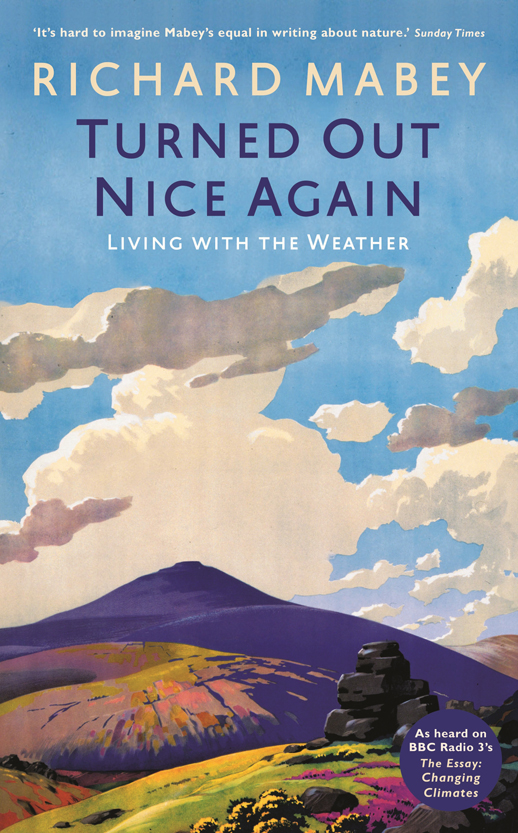Review by Rob St John
The changing moods of the British weather infuse our language, habits, art, myth and memory: providing a common ground for description, expression and interaction. In Turned Out Nice Again, Richard Mabey takes this common isobar-influenced idiom as a starting point to explore how barometers of British self-identity, community and place are steeped with the mercurial moods of our prevailing weather systems. It is a highly personal little book, brimming with taut, descriptive prose: as if you are beside Mabey on a country walk, recalling and reflecting upon memories, stories and climatic curios.
The reason for the British preoccupation with weather – in Mabey’s view – is our ‘whimsical’ weather, a function of our island’s position in the middle of the Atlantic Storm Belt. So whilst downpours and drizzle soak through many British days, we are very unlikely to experience the several feet of rain that can fall every day in a tropical monsoon. And our equal measures of frosty fascination and fury at heavy snowfall hardly compare to the experience of deep freezes elsewhere.
For Mabey, these ‘ambivalent, not to say contrary responses, to the weather’ are unique to Britain. Indeed, it is suggested that the British have more proverbs for weather than the Inuit have words for snow. And these climatic peaks and troughs have inspired legions of artists and writers: from Constable, Turner and Kurt Jackson’s art, to Coleridge and Wordsworth’s poetry and proto-citizen scientist Gilbert White’s 18th century domestic documentation of the role of weather in everyday life.
A keen sense of scale orientates the book. It is repeatedly stressed that weather does not equal climate. Climate is the long-term context in which fluctuations in weather systems occur, much as the weather is the prevailing context for individual’s moods, habits and interactions. Much of the most illuminating writing here is highly personal, as Mabey describes the effect of weather on our own microbiological weather systems, in some cases leading to Seasonal Affective Disorder. There are echoes here of Mabey’s Nature Cure, in which he describes a period of deep depression (the linguistic echoes between weather and emotion run deep) followed by recovery, a line traced by an walking through the environments around him.
Whilst Turned Out Nice Again is in many ways a lighter, more accessible book than this and much of Mabey’s previous work, the acute, personal links between weather and mood are evident. Winter time can be trying for anyone, regardless of prevailing mental states, and Mabey admits his continued seasonal doldrums, as evidenced by his concern for exhausted migrating redwings blown onto the Norfolk coast in a blizzard, ‘their emaciated bodies already like dark absences against the whiteness’. These ‘dark absences’ also aptly suggest the subdued, hibernation state many people slip into in the white and grey of winter, an insulated veil against prevailing meteorological and psychological weather.
But from these periods of low pressure, where the murk of mist, rain and snow smudge the sky into an indistinguishable horizon, comes change, tracked here through the concept of ‘isophenes’. Isophenes are the lines used by ecologists to map the emergence of vegetation as it tracks the warming spring weather north. In Britain, isophenes move north at a pace of roughly two miles an hour, which suggests that it would be possible to keep pace on foot with the seasonal blossoming and northward unfurling of flowers and leaves.
Mabey’s eye for precise, lyrical description and historical detail elevates Turned Out Nice Again above the tangle of polite, pastoral platitudes that litter current nature-writing. We learn that in Mediterranean mythology, the kingfisher (alkuon in Greek) was said to incubate its eggs on the surface of the sea during calm periods of weather, leading to the phrase ‘halycon days’ to describe a period of settled, peaceful happiness. For Mabey, the kingfisher is a ‘spark of iridescent azure and cinnamon that is like a flash of fair weather lightning’. This Tyndall-blue reflection and refraction of weather and mood echoes Robert Macfarlane’s description in The Old Ways of a ‘kingfisher dawn’ of orange culmulus clouds on the edge of blue sky streaked with white cirrus wisps at dawn on the South Downs.
The book’s coda, a reflection on changes in climate – and resulting needs to remedy human induced factors – is subtly political and polemical. Perhaps Mabey could have gone further with this theme. The value and importance of personal, individualistic interactions with weather – built convincingly through the book – perhaps could have been extended to emphasise the empowering actions that individuals and communities may take to reduce their impact on the climatic systems that subtly shape and imbue their lives.
Instead, Mabey discusses fallible and failed grand governmental projects such as iron enrichment of the oceans (to encourage plankton growth which will lock up atmospheric carbon in the oceans), and solar parasols in space (to reduce incoming solar radiation). For such an inherently personal book, this implied reliance on governments to allay climate changes predominantly from the top down feels like a missed opportunity to encourage the role of the individual in making positive changes to reduce climate change. But, this aside, Turned Out Nice Again is a fascinating, beautifully written wee book, likely to engage and enthuse readers with the weather patterns that seep into their everyday lives.
